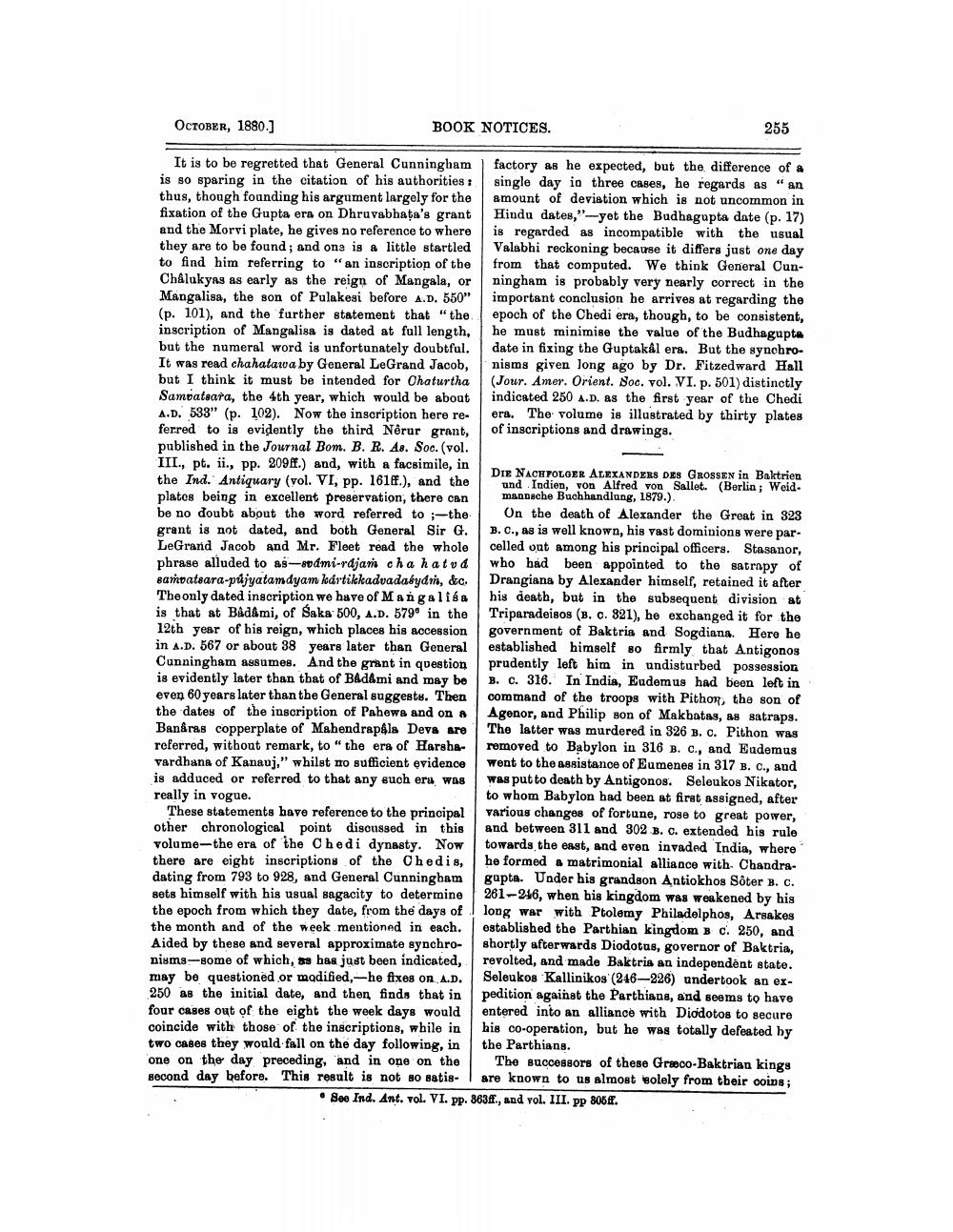________________
OCTOBER, 1880.]
BOOK NOTICES.
255
It is to be regretted that General Cunningham factory as he expected, but the difference of a is so sparing in the citation of his authorities : single day in three cases, he regards as "an thus, though founding his argument largely for the amount of deviation which is not uncommon in fixation of the Gupta era on Dhruvabhata's grant Hindu dates,"-yet the Budhagupta date (p. 17) and the Morvi plate, he gives no reference to where is regarded as incompatible with the usual they are to be found; and one is a little startled Valabhi reckoning because it differs just one day to find him referring to "an inscription of the from that computed. We think General CunChâlukyas as early as the reign of Mangala, orningham is probably very nearly correct in the Mangalisa, the son of Pulakesi before A.D. 550" important conclusion he arrives at regarding the (p. 101), and the further statement that "the epoch of the Chedi era, though, to be consistent, inscription of Mangalisa is dated at full length, he must minimise the value of the Budhagupta but the numeral word is unfortunately doubtful. dato in fixing the Guptakål era. But the synobroIt was read chahatawa by General LeGrand Jacob, nisms given long ago by Dr. Fitzedward Hall but I think it must be intended for Chaturtha (Jour. Amer. Orient. Soc. vol. VI. p. 501) distinctly Samvatsara, the 4th year, which would be about indicated 250 A.D. as the first year of the Chedi A.D. 533" (p. 102). Now the inscription here re. era. The volume is illustrated by thirty plates ferred to is evidently the third Nerur grant, of inscriptions and drawings. published in the Journal Bom. B. R. As. Soc. (vol. III., pt. ii., pp. 2098.) and, with a facsimile, in
Die NACH POLOER ALEXANDERS DES GROSSEN in Baktrien the Ind. Antiquary (vol. VI, pp. 1618.), and the
und Indien, von Alfred von Sallet. (Berlin; Weid. platos being in excellent preservation, there can mannache Buchhandlung, 1879.). be no doubt about the word referred to ;-the On the death of Alexander the Great in 323
rant is not dated, and both General Sir G. B.C., as is well known, his vast dominions were par. LeGrand Jacob and Mr. Fleet read the whole celled out among his principal officers. Stasanor, phrase alluded to as-Sámi-rdjan cha hatua who had been appointed to the satrapy of samvatsara-pujyatamdyam keartikkadvadasydri, &c. Drangiana by Alexander himself, retained it after The only dated inscription we have of Mangalia his death, but in the subsequent division at is that at Badami, of Saka 500, A.D. 579' in the Triparadeisos (B. c. 821), he exchanged it for the 12th year of his reign, which places his accession government of Baktris and Sogdiana. Here he in A.D. 567 or about 38 years later than General established himself so firmly that Antigonos Cunningham assumes. And the grant in question prudently left him in undisturbed possession is evidently later than that of Badâmi and may be B. C. 316. In India, Eudemus had been left in even 60 years later than the General suggests. Then command of the troops with Pithon, the son of the dates of the inscription of Pahews and on a Agenor, and Philip son of Makbatas, as satraps. Banaras copperplate of Mahendrapela Deva are The latter was murdered in 326 B. c. Pithon was referred, without remark, to "the era of Harsha- removed to Babylon in 316 B. C., and Eudemus vardhana of Kanauj," whilst no sufficient evidence went to the assistance of Eumenes in 317 B. C., and is adduced or referred to that any such ers was was put to death by Antigonos. Seleukos Nikator, really in vogue.
to whom Babylon had been at first assigned, after These statements have reference to the principal various changes of fortune, rose to great power, other chronological point discussed in this and between 311 and 302 B. C. extended his rule volume-the era of the Chedi dynasty. Now towards the east, and even invaded India, where there are eight inscriptions of the Chedis, he formed a matrimonial alliance with Chandradating from 793 to 928, and General Cunningham gapta. Under his grandson Antiokhos Sôter B. c. gets himself with his usual sagacity to determine 261-246, when his kingdom was weakened by his the epoch from which they date, from the days of long war with Ptolemy Philadelphos, Arsakes the month and of the week mentioned in each. established the Parthian kingdom B c. 250, and Aided by these and several approximate synchro- shortly afterwards Diodotus, governor of Baktria, nisms--some of which, ss has just been indicated, revolted, and made Baktris an independent state. may be questioned or modified, -he fixes on A.D. Seleukos Kallinikos (246-226) undertook an ex250 as the initial date, and then finds that in pedition against the Parthians, and seems to have four cases out of the eight the week days would entered into an alliance with Diodotos to secure coincide with those of the inscriptions, while in his co-operation, but he was totally defeated by two cases they would fall on the day following, in the Parthians. one on the day preceding, and in one on the The successors of these Graeco-Baktrian kings second day before. This result is not so satis. I are known to us almost wolely from their coins;
• See Ind. Ant. vol. VI. pp. 883f., and vol. III. pp 806fF.




